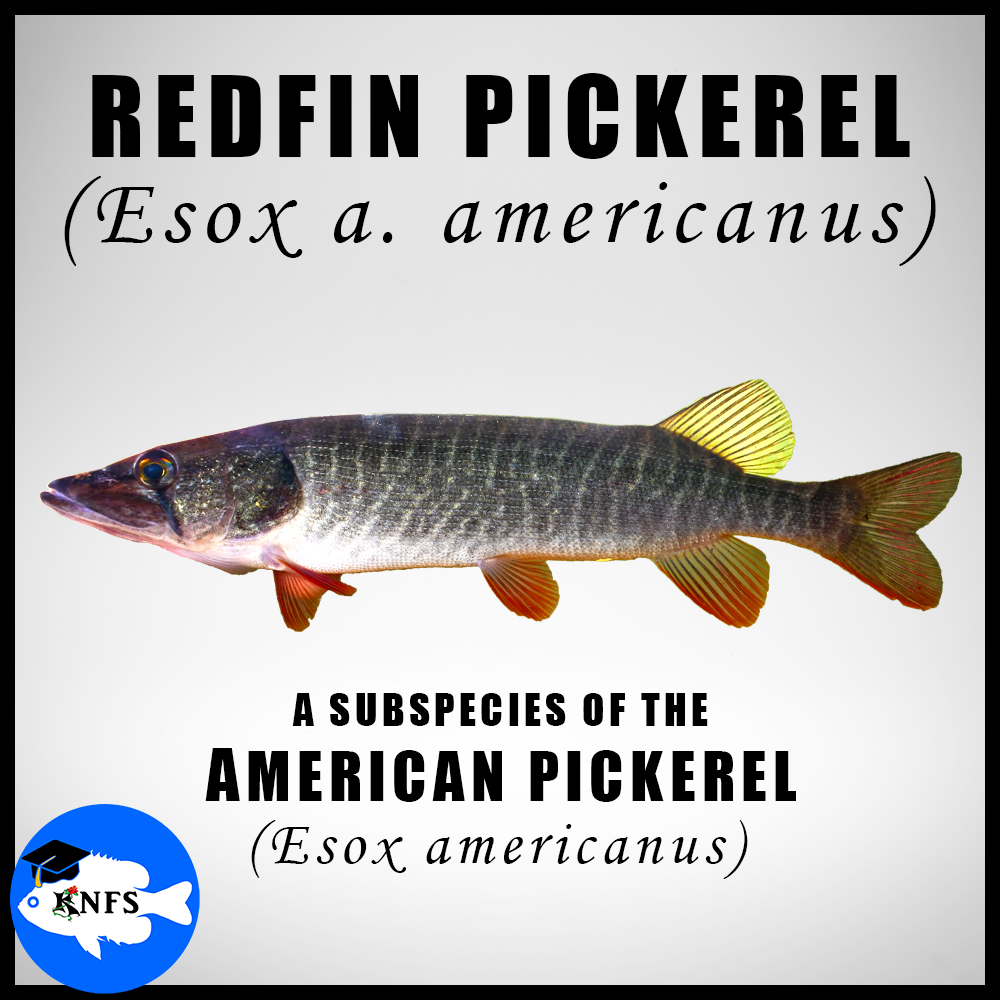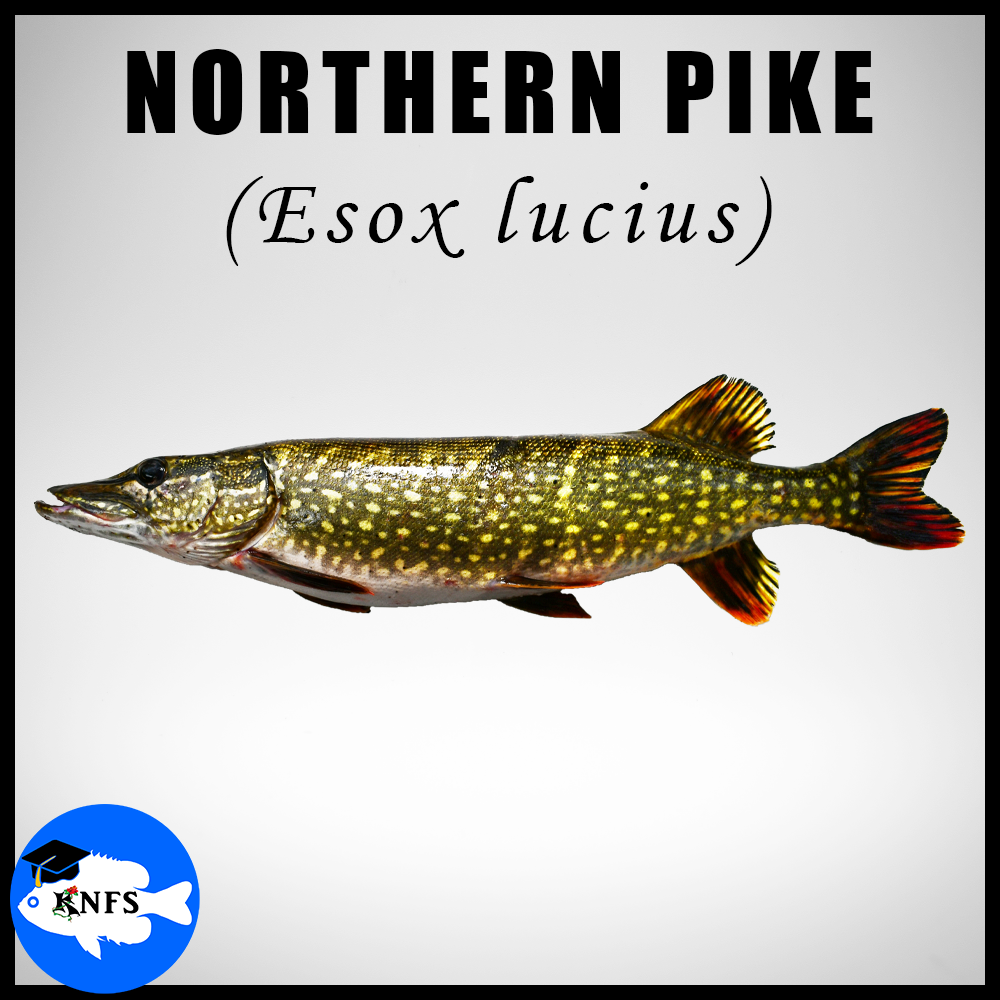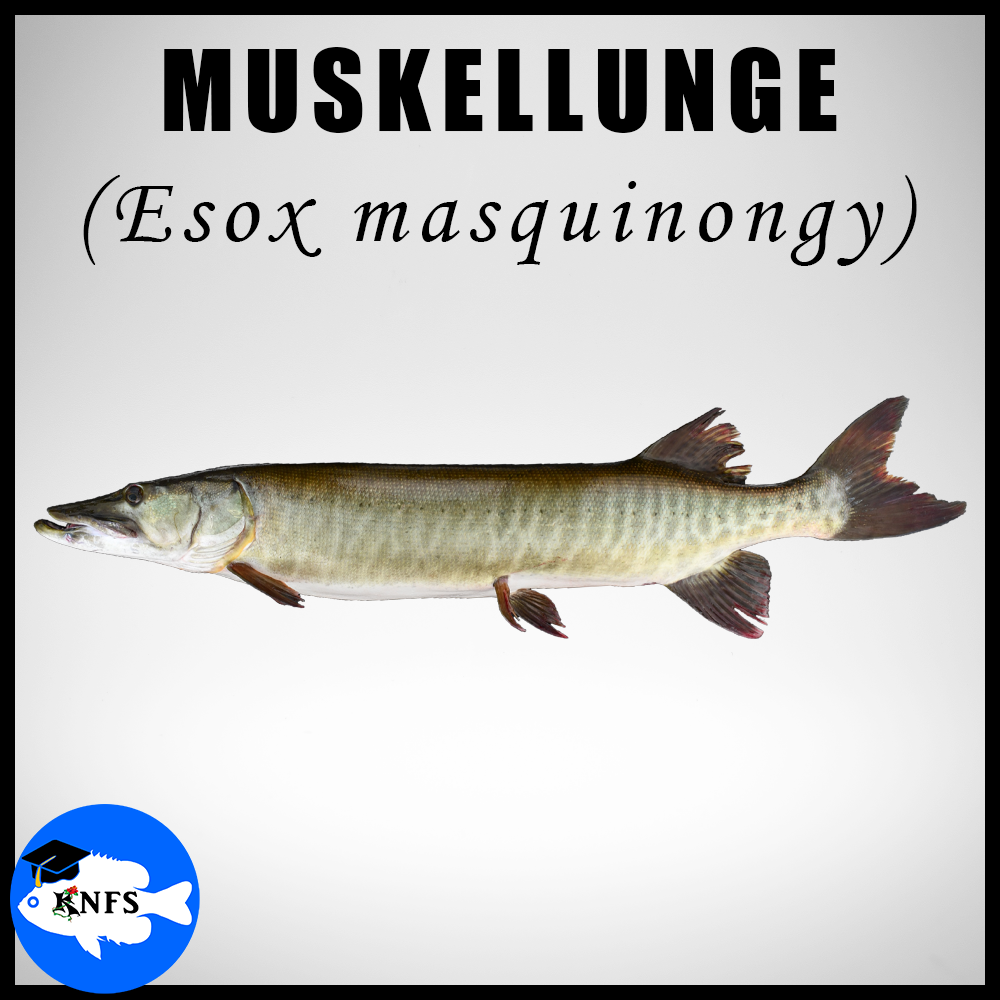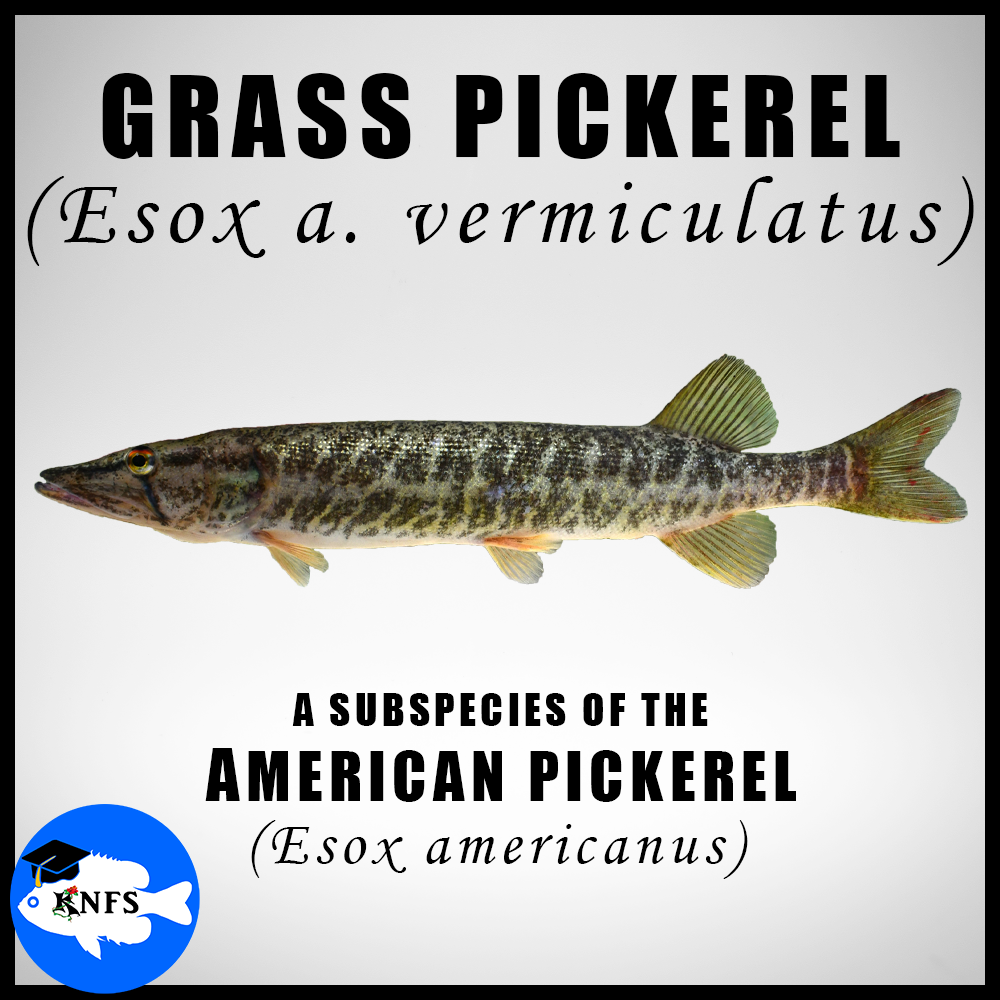By Koaw 2023,
This hybrid will be examined. Click to enlarge the photo.
HYBRID INTRO: Hybridization within the genus Esox has been fairly well documented for the last 80 years or so where at least 6 intrageneric (within genus) hybrids have been known to naturally occur in North America. Artificial crossings, or crossings where humans have interfered to assist the hybridization process, have produced even more variations of hybrids. [1-6]
The naturally produced known-hybrids in North America are (1) E. niger (chain pickerel) x E. a. americanus (redfin pickerel), (2) E. niger x E. a. vermiculatus (grass pickerel), (3) E. masquinongy (muskellunge) x E. lucius (northern pike), (4) E. lucius x E. niger, (5) E. lucius x E. a. americanus, and (6) E. lucius x E. a. vermiculatus.
The subspecies of the American pickerel (Esox americanus) are the grass pickerel (E. a. vermiculatus) and the redfin pickerel (E. a. americanus). These subspecies are considered as unique fishes in the above ‘natural hybrid’ considerations while their crossing (E. a. americanus x E. a. vermiculatus), though also a viable and naturally found crossing in a very limited range, is an intraspecific (within species) crossing and not considered as a natural interspecific hybrid for these considerations; there are many intergrades in the southeastern United States that have mixed genetics between both subspecies.
The chain pickerel (Esox niger) x redfin pickerel (Esox americanus americanus) hybrid may be considered the second most likely hybrid to encounter behind the tiger muskellunge hybrid (E. masquinongy x E. lucius), perhaps even occurring naturally with more frequency. Both of these fishes have overlapping ranges, high survivability of hybrid offspring, and fewer physical/psychological mating barriers than what exists between the two larger species, the muskellunge and northern pike. Muskellunge tend to spawn later than any other member of Esox as well as in different locations than the redfin pickerel. Most sexual mature muskellunge are large enough to consider most sexual mature redfin pickerel as prey rather than a mating option. Northern pike seem to have more gamete incompatibilities with the pickerels, especially when a female northern pike is involved. [2]
IDENTIFYING HYBRIDS: Identifying hybrids is often very tricky. This author spent numerous hours analyzing the various intrageneric hybrids within the genus Lepomis for the common sunfishes guide and again for this Esox guide. Hybrids offer serious challenges for identification—it’s not easy. However, there are certain steps that can be taken to better understand a possible hybrid.
Hybrids are strange because they express the combined shuffling of DNA from two unique species. As genetics are being swapped between two different species, there’s more tendency for odd features to arise, not just in coloration and patterning but also within the meristics (countable features) and morphometrics (measurable features). Although most features will be intermediate between the parent species, there will be some features that resemble more closely or almost entirely towards one parent species. At various stages of development some hybrids may resemble almost entirely like one parent species.
A genetic test is truly the best way to ensure an identification is correct on a hybrid. However, genetic tests are primarily only used by researchers and fisheries managers. On this page we’ll demonstrate with this hybrid breakdown how we, as identifiers not wanting to rely on genetic tests, can come to a best guess with good evidence.
PHOTOS: If you suspect you have a hybrid then get as many photos as possible of all possible angles. Ideally your photos should be able to see the # of submandibular pores underneath the jaw, the scalation on the cheek & operculum, the # of branchiostegal rays, the # of lateral line scales, and the ray counts on the fins, specifically the dorsal and anal fin. Photos of the belly between the pelvic fins may be beneficial as well as well as a photo of the fish’s back that includes the top of the head. Having a flat measurer in each photo is also helpful for reference.
HYBRID BREAKDOWN: For this examination a single lateral photograph of suspected natural hybrid redfin pickerel (E. a. americanus) x chain pickerel (E. niger) will be analyzed. This image is courtesy of Robert Jacobs of CT Deep Fisheries. The specimen is 9 in (23 cm) TL and from unknown waters in Connecticut where natural populations of both parent species exist. Having only a single photograph will make this identification tougher.
Hybrids of Esox will have the same basic features as the pure species of the genus: 1) There’s a single dorsal fin far back on the body. 2) The caudal fin is forked. 3) The lateral scales are numerous and are relatively small. 4) There’s a ‘duck-bill’ like snout/mouth. 5) There’s an elongated body. (Remember that all the gar species have a rounded tail fin, not forked.)
For this hybrid breakdown, we’ll assume that the parent species are unknown and need to be discovered.
HYBRID OR NOT?: Firstly, the fish must be considered a hybrid to initiate a hybrid analysis. Unfortunately, this is easier said than done. For the most part, only ichthyologists, fisheries scientists, and astute anglers who encounter these species with frequency will immediately recognize a hybrid. Like mentioned earlier, some hybrids may look entirely like one of the parent species. It’s quite likely that many encountered hybrids actually go unnoticed as hybrids.
On a hybrid, the pattern/coloration will most likely be different from any of the pure species, most apparent after the early juvenile stages, past ~2-3 inches in total length. Furthermore, the overall meristics and morphometrics will be different from the pure species, though a lot of overlap will occur. This Esox guide has attempted to provide adequate displays of most stages of development for most species on the individual species pages as well as the normal range of variance for important meristic features.
QUICK CHECK: Use the Quick Esox Identification App/Key to see if the fish fits the feature profile of a pure species. If the fish appears ‘off’ and/or has meristics that don’t fit within the normal range of any pure species, then it may very well be a hybrid. (Keep in mind that some hybrids may have meristics that completely align with one parent species.)
THIS SPECIMEN: The specimen under analysis immediately stands-out as unusual because of the lateral pattern. No pure species of Esox at this size of 9 in (23cm) has very thin & almost black bars displayed as such. The redfin pickerel, at times, may have a pattern similar to this, usually with a lighter shade of brown on thicker bars and/or more of a vermiculated pattern, or a pattern with more irregular lines. A pure redfin pickerel at this size would be expected to have more vibrant orange in the fins. There are other features that seem odd such as maxilla extension, snout length, and overall shape of the snout, however, those features are really only noticeable to an eye familiar with these species within Esox. We’ll discuss these features below.
RANGE: The next step should be to discover what possible species could be the parent species. In Connecticut there are only three species of Esox with established populations: redfin pickerel, chain pickerel, and northern pike. Each of these three species will be considered as potential parents. The individual species pages show the range maps for each species.
Adults and juveniles of all possible parent species.
Compared to our hybrid under analysis, the redfin pickerel immediately seems like the most similar looking species.
CROSSING NOTES: As mentioned earlier, the redfin pickerel x chain pickerel is probably the second most encountered hybrid. Artificial hybridizations of these two species have shown very successful hatches for both reciprocal parental crossings. Even the hybrids from these crossings are fertile and capable of producing offspring. [2]
Click to enlarge.
The northern pike appears to only have success crossing with chain pickerel and redfin pickerel if the northern pike parent is male. Only a few natural redfin pickerel x northern pike hybrids have ever been observed. Artificial crossings of these species show minimal-to-fair hatching success. [2] Ergo, redfin pickerel x northern pike crossings are likely very rare as there seems to be more gamete incompatibility than with any other interspecific crossings within the genus here in North America.
EXAMINE THE TOP FOUR MERISTICS: Examining the scalation of the cheek & operculum, counting the lateral scales along the lateral line, counting the branchiostegal rays, and counting the submandibular pores should be always be checked; same is done when verifying pure species. Unfortunately, from this single lateral photo, we can only analyze the first two of those aforementioned features.
SCALATION ON THE CHEEK/OPERCULUM: This specimen clearly shows both a cheek and an operculum that are mostly scaled. The cheek could definitely be considered 100% scaled and perhaps the operculum too, though, the preopercle (the frontmost bone of the operculum) may be lacking some scales, of which, is typical even for the pickerels. The photo isn’t quite clear enough to see if the scales are all the way down on the preopercle, or that frontmost bone of the operculum.
Both the redfin pickerel and the chain pickerel will show a cheek and operculum that are mostly scaled while the northern pike usually shows an operculum that is only partially scaled, often about half-scaled.
Redfin pickerel x northern pike crosses have been shown to have scalation on the operculum ranging from 30-100%, while redfin x chain pickerel crosses have shown scalation on the operculum at 100%, and the northern pike x chain pickerel hybrids have shown scalation ranging from 70-90%. Under this examination for this one feature, the redfin x chain cross seems most probable as a fit for our hybrid under analysis. However, examining one feature is not nearly enough for a confident analysis. [1] [6]
Keep in mind that scalation on the cheek/operculum may not yet be developed on young juveniles. On pure muskellunge (E. masquinongy) the cheek/operculum may not yet show scalation even by 8 in (20 cm). [3] A redfin pickerel of this size will already be an older adult and definitely expressing that scalation.
LATERAL LINE SCALES: Ideally, we’d only like to examine the range of lateral scales for the local populations of each species. Since that is out of the question here, we’ll use the overall ranges for each species. Our specimen has about 121-122 lateral line scales; (it’s a bit tricky to count some scales on this photo.)
Click to enlarge.
Northern pike have a very large range of lateral scales 105-148 but mostly show a range between 120-135. The chain pickerel also typically shows 120-135 lateral scales with a range of 114-138. The redfin pickerel usually shows 96-109 lateral scales with a range of 94-117(118). [7-9] The lateral line scale count for our specimen falls within the expected ranges of northern pike and chain pickerel.
Certain hybrids of the chain pickerel x northern pike have shown lateral scale counts between 118-132. Northern pike x redfin pickerel hybrids have shown scale counts of 103 and 112-120. The chain pickerel x redfin pickerel has shown scale counts between 90-120. [1] [6]
If based of previous reports, this specimen is showing a lateral scale count closer to what has been seen between chain pickerel and northern pike. That adds a bit of confusion to our over analysis as the cheek/operculum feature of our hybrid leans more towards a redfin pickerel x chain pickerel. However, keep in mind that the hybrid data available for comparison is very minimal and not to be taken as the exact-and-only range. (The two redfin pickerel x chain pickerel hybrids that I’ve analyzed for this guide both showed higher lateral scale counts, the ~121-122 (this specimen in question) and ~130; I’ve added these data to my summary data table below.)
The good news from this lateral line scale count is that it further contributes evidence that this fish is a hybrid. That high number of lateral scales fits outside the range of the redfin pickerel. We now know that this fish, that mostly resembles a redfin pickerel, does not have meristics that fit within the normal range of a redfin pickerel. (Although we haven’t yet covered why a redfin pickerel is a parent, I assure that one parent is a redfin pickerel.)
BRANCHIOSTEGAL RAYS: Although we can’t count the branchiostegal rays on our specimen from this lateral photo, I will present some known ranges:
Most populations of chain pickerel show a range of branchiostegal rays of 14-17 on a single lateral side where possibly 12-13 may show up in some populations. Northern pike usually show between 13-16. Redfin pickerel typically have 11-13 with an expanded range of 10-16.
The redfin pickerel x chain pickerel has shown a range of 14-16 branchiostegal rays. 13-17 for the chain pickerel x northern pike and 13-16 for the northern pike x redfin pickerel.
Really, the branchiostegal ray count will not offer too much benefit towards an identification either way.
Select data for Esox and Esox hybrids. Click to enlarge.
SUBMANDIBULAR PORES: Likewise, as we can’t count the submandibular pores on our specimen of analysis from this lateral photo, here are the known ranges of submandibular pores:
Both chain pickerel and redfin pickerel almost always show a 4/4 count of submandibular pores, sometimes 3/4 & 4/5 count show up. The northern pike usually shows 5/5 submandibular pores where counts of 4/5 and 5/6 appear with much less frequency.
The redfin pickerel x chain pickerel cross usually produces 4/4 count, where sometimes 5 pores show up on one side. The redfin pickerel x northern pike cross has shown between 3-5 pores on a single side. Curiously, for this redfin x northern cross, Crossman & Buss (1965) reported 7 of 10 individuals showing 3 pores on a single side, of which, is not too frequent even on a pure redfin pickerel; only 1 of 10 fish showed 5 pores on a single side. The northern pike x chain pickerel cross has produced both 4 and 5 pores on a single side.
Again, a submandibular pore count would have offered little help to this analysis. If a muskellunge were a possible parent species, then we would wish to know the submandibular pore count as it would have likely been 5 or higher on a single lateral side.
SO FAR: As of now, we know our specimen has a mostly scaled cheek and operculum and has about 121-122 lateral scales. The cheek/operculum scalation mostly suggests a crossing between a redfin pickerel and chain pickerel. The count of 121-122 lateral scales doesn’t clear up much except that this fish is not a pure redfin pickerel.
ANAL RAYS & DORSAL RAYS: This photo would not give us a confident count on ray counts in the fins. Yeah, we could guess with fair accuracy—but often guessing could lead to a wrong result, then causing a misidentification. I believe there’s sufficient evidence from other features so as to not need an examination of the anal rays and dorsal rays. Those counts are still provided in the data table for reference.
MORPHOMETRICS: Measurable features, or morphometrics, often give clues as to a potential parent species. We naturally notice the morphometrics of a fish the moment we pull it from the water; we don’t even need a measuring tape or calipers. The principal is the same as when we analyze the faces and bodies of other humans—our brains instinctively analyze the overall shape and how certain parts (nose, eyes, body) compare to other parts. If you are familiar with certain species of fishes, then you often immediately notice when a fish has a deformity and/or just looks weird.
Click to enlarge this snout comparison.
The hybrid in question clearly expresses redfin pickerel traits on the snout. Firstly, the snout is flat, almost slightly convex rather than concave; a mature redfin pickerel almost always has an almost convex snout, or one that is bent outwards rather than inwards (though, there will always be a little concave depression in the snout.) Even compared to the grass pickerel, the redfin pickerel’s snout is often more convex—or at least lacking much concavity. Both the northern pike and chain pickerel will show a longer, more concave snout than a redfin pickerel.
Secondly, the snout is extremely short both relative to the standard length as well as the length of the postorbital length of the head. If measuring point-to-point (from the same plane, i.e. a flat photo), the snout length of this hybrid fits into the postorbital length of the head 1.25x (PToL/SnL)). (Measuring from orbital rim to bony extension of operculum for PToL and from tip of upper jaw to orbital rim for SnL.) Select and limited data collected for this guide compared snout length data for species of Esox, of which, is an agreement with overlying trends from various publications, though measuring methods may slightly vary. [9] [7] [2]
For a general idea, a mature redfin pickerel may be expected to show a PToL/SnL around 1.43x with a range of (1.3-1.53x). Crossman’s proposed range for redfin pickerel PToL/SnL is slightly different at 1.2-1.4x with a range of (1.0-1.4x); however, his data includes juveniles at least as small as 80mm and his measuring method may slightly differ. [9] A mature redfin pickerel will almost always have a shorter snout via the PToL/SnL ratio than a young redfin pickerel.
The snout length for chain pickerel may be expected to fit into the postorbital length 0.94x on average (PToL/SnL) with a range of (0.78x – 1.13x) (including some juvenile specimens.) Northern pike may be expected to show a PToL/SnL of 1.13x with a range of (0.86x-1.3x) (including some juveniles.) [8] (PoL/SnL) with a mean range of 1.2-1.4x (all data range 1.0-1.4)
The 1.25x PToL/SnL of the hybrid in question as well as the shape of the snout suggests a redfin pickerel is one of the parent species. If the parent species were the northern pike x chain pickerel, then we would expect a snout that is longer and slightly more concave.
Crossman & Buss (1965) reports a PToL/SnL for the chain pickerel x northern pike hybrid at 0.88-0.93. (Any PToL/SnL smaller than 1 means the snout length is longer than the postorbital length of the head.) A PToL/SnL of 0.89x – 1.01x was reported for the northern pike x redfin pickerel hybrid. The female chain pickerel x male redfin pickerel showed a PToL/SnL of 0.91x-1.07x, and for the inverse cross of these species, a PToL/SnL of 1.02x-1.12x. For their data, they reported using measuring methods from Hubbs and Lagler (1958); this doesn’t clear up if they measured past the bone of the operculum and included the fleshy extension of the operculum for the PToL; it also doesn’t clear up if they measured on a flat plane for the SnL or literally measured from the central anterior point of the snout to the lateral side of an orbit, though that would be unlikely. [10] This data is also a bit misleading because it seems that a great number of specimens at or below 100 mm were measured; the snout length and overall body morphometrics of juveniles at that size differ greatly from late stage juveniles to adults.
Similar to the PToL/SnL, data is provided from Crossman & Buss (1965) in the data table for SL/SnL if interested in examining a specimen with this feature.
Compared against the aforementioned data of known PToL/SnL for hybrids, a chain pickerel x redfin pickerel best fits for this feature.
MAXILLA: Whenever suspecting a redfin pickerel is involved, it’s useful to look at the position of the maxilla vs. position of the pupil in the eye. Most mature redfin pickerel have a maxilla that extends at least past the anterior edge of the pupil, if not farther. Most chain pickerel and northern pike do not have the maxilla extending past the anterior edge of the pupil and only occasionally past the anterior edge of the eye. This fish expresses a clear intermediacy of the maxilla vs. pupil feature. This doesn’t eliminate any possible parent species, but it contributes evidence that this is not a pure redfin pickerel.
WHERE WE’RE AT: The redfin pickerel is a parent species because no other species of Esox can explain the snout length and shape. The chain pickerel x northern pike cross is eliminated from contention because the snout is too short. Now, it must be decided if a northern pike or a chain pickerel is the other parent species.
PATTERNING & COLORATION: We’ve already established that the dark lateral bars appear odd, as no pure species usually expresses such thin black bars with such large pale spaces between the bars. However, the lateral pattern most closely resembles what is seen on a redfin pickerel.
When examining hybrids, its most helpful to analyze all possible species from the same body of water/drainage, especially specimens of similar sizes to the hybrid under analysis. As we can’t quite do that without knowing exactly where this fish came from, we can at least examine parent species in Connecticut, of which, is the same state that this hybrid came from; (see adjacent photo.) It’s also important to analyze specimens of similar size as patterning/coloration differs for all species during different stages of development. (I was unable to provide a photo of a northern pike from Connecticut at around 20 cm, and instead have one for 32 cm.)
Various species and hybrids within Esox. Click to enlarge.
Analyzing verified hybrids is also very helpful. Looking for traits that are specific to one parent species that may exist on a hybrid is helpful. None of the pickerels will have dark spotting/blotches in the distal parts of the fins like is seen in the northern pike. Though, the pickerels, especially the chain pickerel, will usually retain dark blotches that remain close and connect to the fin bases, slightly extending outwards on the distal margins. The hybrid in our analysis doesn’t show any blotching or spotting in the fins. This doesn’t necessarily suggest a northern pike cannot be a parent species, as northern pike x pickerel hybrids may not have obvious spotting in the fins. Not much is revealed, but it was still worth examining.
The fin colors of the hybrid in question are a bit odd compared to any pure species of this size. A pure redfin at 9.1 in (23.0 cm) would likely have more vibrant fins with orange and/or red (definitely red if in the Carolinas) as well as more color in the anal fin and possibly within the dorsal fin & ventral margins of the caudal fin. Chain pickerel of this size typically have mostly clear fins with the yellowish-dusky colors just starting to appear. Northern pike of this size has developed or is just starting to develop dark spotting and color in the fins, usually a combination of yellow, red, and orange. Unfortunately, we can’t really eliminate any species from contention based on the fin colors. We can just notice that the color doesn’t match any pure species.
The body color, like the fin color, doesn’t really help eliminate any parent species from contention. The hybrid expresses what could be a combination of colors from any of the parent species. The redfin colors do seem apparent within the hybrid.
Examining the suborbital bar (teardrop) will not offer too much help. All possible parent species have a fairly conspicuous to very prominent suborbital bar while at a similar size to the hybrid in question. The northern pike’s teardrop does become much less conspicuous starting around the late-juvenile stage. However, most pickerel x northern pike crosses seem to maintain a fairly prominent suborbital bar. Usually, the suborbital bar on a redfin pickerel will have the most extended angle, however, I’ve observed a number of adult specimens that have almost vertical suborbital bars.
Comparing our hybrid in question vs. the provided hybrid photos, we can clearly see that the redfin pickerel x chain pickerel hybrid from both parental crossings appears most like our fish. On the redfin x chain hybrid, the dark lines in the patterning are fairly thin and somewhat irregular. While on the chain pickerel (female) x northern pike (male) hybrid, the dark lines are much thicker and a bit more consistent.
This difference in bar size and presentation along the body may seem like it shouldn’t carry much weight for identification—but I assure you that it does. The presentation of the darker, very thick bars separated by pale, much thinner bars is a classic feature of young northern pike—and apparently also of the redfin pickerel x northern pike hybrid; the hybrid in question is expressing the exact inverse of the northern pike and northern pike x pickerel hybrid presentation, instead showing very thin dark bars.
There are no verified northern pike (female) x redfin pickerel (male) crossing photos as this cross did not produce survivable offspring during artificial hybridization attempts. [2] A chain pickerel is most likely the other parent species.
All evidence suggests that the hybrid in question is a redfin pickerel x chain pickerel.
SUMMARY OF THE HYBRID BREAKDOWN:
The species of Esox that are local to this hybrid’s location are that of the redfin pickerel, chain pickerel, and northern pike.
The hybrid most resembles a redfin pickerel based on snout length/shape, body pattern, and coloration. The patterning and coloration on the hybrid does not match normal variance of a redfin pickerel.
The hybrid does not fit the normal meristics of a pure redfin pickerel based off the lateral scale count of 121-122.
The maxilla extending past the eye but not to the anterior edge of the pupil also suggests this is not a pure redfin pickerel.
The cheek/operculum both being fully scaled most suggests a chain pickerel x redfin pickerel hybrid, though this cannot eliminate a redfin x northern pike hybrid.
The length of the snout vs. the postorbital length of the head (PToL/SnL) as well as the flat/convex shape of the snout strongly suggests a redfin pickerel must be a parent species.
The PToL/SnL of 1.25x more suggests a redfin pickerel x chain pickerel than the other possible crossings.
No obvious characteristics unique to the northern pike appear on the hybrid in question.
The body pattern of the hybrid most closely resembles the verified photos of redfin pickerel x chain pickerel crosses. A chain pickerel is most likely the other hybrid parent.
Redfin pickerel x northern pike crosses are far less likely to occur naturally than chain pickerel x redfin pickerel crosses. Northern pike x redfin pickerel crosses suffer more gamete incompatibilities as well as other barriers such as a greater size difference, spawning habitat preference, and breeding rituals.
Redfin pickerel x chain pickerel best explains this hybrid. A genetic sample would be necessary for the utmost certainty.
REFERENCES:
[1] E. Crossman and K. Buss, "Hybridization in the Family Esocidae," J. Fish. Res. Bd., vol. 22, no. 5, 1965.
[2] K. Buss and J. Miller, "Interspecific Hybridization of Esocids Interspecific Hybridization of Esocids F1 Hybrids," U.S. Department of the Interior, Bureau of Sport Fisheries and Wildlife, 1967.
[3] J. D. Black and L. O. Williamson, "Artificial hybrids between muskellunge and northern pike.," Trans. of the Wisc. Aca. of Sci., vol. 38, pp. 299-314, 1946.
[4] S. Eddy, "Hybridization between Northern Pike (Esox lucius) and Muskellunge (Esox masquinongy)," Jour. of the Minn. Acad. of Sci., vol. 12, no. 1, pp. 38-43, 1944.
[5] D. V. McCarraher, "Pike hybrids (Esox lucius x E. vermiculatus) in a Sandhill Lake, Nebraska," Transactions of the American Fisheries Society, 1960.
[6] E. C. Raney, "Natural hybrids between two species of pickerel (Esox) in Stearns Pond, Massachusetts. Supp't to Fish. Rept. for some central, eastern and western Mass. lakes, ponds and reservoirs, 1951-1952," 1955.
[7] J. M. Casselman, E. J. Crossman, P. E. Ihssen, J. D. Reist and H. E. Booke, "Identification of Muskellunge, Northern Pike, and their Hybrids," Am. Fish. Soc. Spec. Publ., vol. 15, pp. 14-46, 1986.
[8] Koaw, "Select Morphometrics and Meristics of Esocids," Koaw Nature - KNFS, 2023.
[9] E. J. Crossman, "A Taxonomic Study of Esox americanus and Its Subspecies in Eastern North America," Copeia, vol. 1, pp. 1-20, 1966.
[10] C. L. Hubbs and K. F. Lagler, "Fishes of the Great Lakes Region, Rev. Ed.," vol. Bull. 26, 1958.
[11] C. L. Hubbs, K. F. Lagler and G. R. Smith, Fishes of the Great Lakes Region: Revised Edition, University of Michigan Press, 2004.









